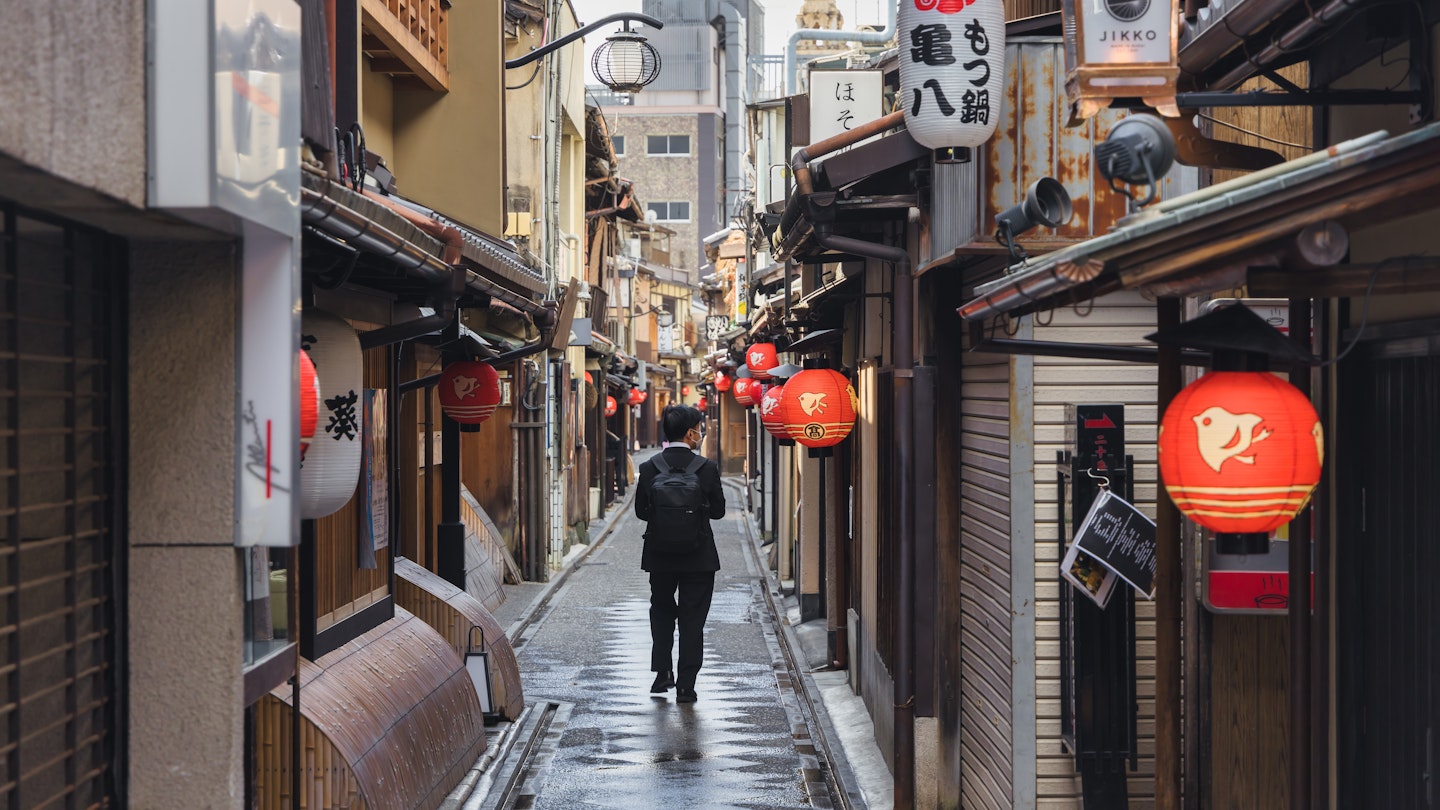Within Kyoto’s historically rich and compact confines, distinctive neighborhoods tell different tales about this storied city.
From the liquor-fueled alleys of nightlife haunt Ponto-chō and the ancient religious iconography of the rolling Higashiyama hills to the Edo-period flagstones and kimono-clad dancers of Gion, venturing through Kyoto is like embarking on a journey through the annals of Japanese history.
Here are the best neighborhoods in Kyoto that you should include on your itinerary.
1. Gion
Best neighborhood for Edo-period culture and traditional arts
Gion’s reputation as an entertainment hub stretches back to the Sengoku Warring States era (1467–1615). Over the centuries, it has evolved into a neighborhood filled with lively tea houses where geisha (known locally as geiko, or “women of the arts”) perform for the ruling classes.
Trademarks of the Edo period (1603–1868), when geisha culture was at its peak with around 500 tea houses in operation, are woven into the very fabric of Gion. Wood-latticed shop fronts and sudare (bamboo veranda screens) flank the roadsides. Kimono-clad geiko and maiko (trainees) gracefully navigate the ancient, lantern-lit walkways. Centuries-old shrines still hold a magnetic appeal for travelers and wandering pilgrims alike.
Part of Gion’s charm lies in simply walking around its atmospheric streets. However, visitors should note that capturing images of resident geisha without permission is a fineable offense.
Don’t miss the 7th-century Yasaka Shrine, a dazzling vermilion edifice dedicated to Susanoo, the younger brother of the sun goddess Amaterasu. A visit to the riverside Minamiza Kabuki theater provides a wonderful introduction to traditional Japanese theater. For those seeking a more immersive experience, renting period-style garments can enhance your exploration further.
Gion is also one of the best neighborhoods in Kyoto for lodging. Its location on the banks of the Kamo River places visitors within walking distance of central Kyoto, the Higashiyama hills, and Ponto-chō across the river, with several charming rental options available down quiet side streets.
2. Higashiyama
Best neighborhood for strolling
Higashiyama, meaning “eastern mountains,” is situated in the foothills east of Kyoto’s city center. The mountain-top temple Kiyomizu-dera, one of the most famous landmarks, exemplifies Edo-period religious architecture and is notable for its wish-granting spring waters.
From the main worship hall’s veranda, you can enjoy breathtaking views of the Kyoto cityscape and its undulating mountain backdrop. The Sannen-zaka and Ninen-zaka alleyways leading up to the temple are filled with shops offering traditional foodstuffs, such as soba noodles and zenzai, a hot sweet soup made from adzuki beans.
For a scenic stroll, the nearby Path of Philosophy connects the 13th-century Nanzen-ji temple with the well-kept gardens of Ginkaku-ji, the Silver Pavilion. This approximately 2km (1.25-mile) walk is especially beautiful during spring hanami (blossom viewing) season, when cherry blossoms create a stunning scene.
Sanjūsangen-dō, a Buddhist temple of the Tendai sect featuring 1001 statues of the Bodhisattva Kannon, is another highlight in the Higashiyama district, providing a serene atmosphere for those seeking respite from the city’s busier sites.
3. Ponto-chō
Best neighborhood for drinking and dining
Ponto-chō is a vibrant yokochō (alleyway) running along the banks of the Kamo River. It comes alive at night, illuminated by paper lanterns and the lively chatter of patrons in its many drinking and dining establishments.
From May through November, riverside restaurants set up temporary outdoor terraces called kawayuka that offer stunning views of the river and promenade. Culinary options in Ponto-chō range from affordable yakitori (grilled chicken) to exquisite kaiseki (multi-course seasonal cuisine), with Wagyu beef being a prominent favorite.
Though Ponto-chō was once a center for geiko, with the focus now shifting across the river to Gion, the nightlife theme remains strong. For classic cocktails and live jazz on weekends, the cozy space of Hello Dolly is a must-visit. Another option is Bar Alchemist, which leans towards modern cocktail mixology.
4. Fushimi
Best neighborhood for Shinto history
The Fushimi neighborhood is home to Fushimi Inari-Taisha, famous for the thousands of vibrant vermilion torii gates that guide pilgrims through a serene cedar forest into the surrounding hills. It is one of Japan’s most revered Inari shrines, dedicated to the Shinto god of rice and prosperity.
Adventurous souls can hike to Mt. Inari’s summit, which provides stunning vistas and a visit to the Kami-no-Yashiro shrine. Given the shrine’s popularity, weekday mornings are typically the best time for visits to avoid crowds.
Around 40 minutes on foot from Fushimi Inari lies Fushimi-Momoyama Castle, a late 16th-century structure initially built as a retirement residence for Toyotomi Hideyoshi, a key figure in Japanese history. Although demolished in 1623, a replica was constructed in 1964, allowing visitors to explore its grounds and enjoy a quieter atmosphere.
5. Nakagyo
Best neighborhood for foodies
Nakagyo, located in the heart of Kyoto, is home to Nijō Castle, a UNESCO World Heritage Site and a notable example of traditional Japanese castle architecture. The castle offers tours where visitors can take in its unique features, including nightingale floors designed to alert residents of intruders.
In addition to the historical site, Nakagyo boasts Nishiki Market, a culinary haven known as Kyoto’s kitchen. Here, you can explore a wide variety of local foods, from exceptional sushi to unique Japanese pickles.
Food enthusiasts will appreciate the nearly 100 Michelin-starred restaurants in Kyoto, many located in Nakagyo. While exploring this food paradise, pre-booking spots in popular establishments is recommended for the best experience.
Despite Nakagyo’s modern urban aesthetic, its central location ensures easy access to the rest of Kyoto via public transport, making it a convenient base for your explorations.




